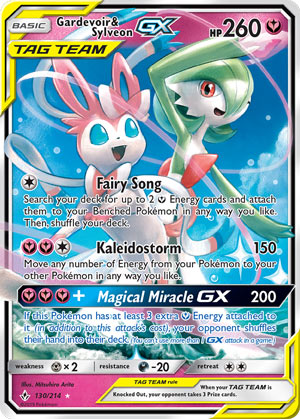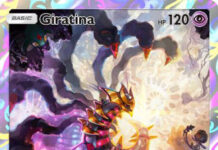
Gardevoir & Sylveon-GX
– Unbroken Bonds
Date Reviewed:
May 7, 2019
Ratings Summary:
Standard: 4.17
Expanded: 3.73
Limited: 4.27
Ratings are based on a 1 to 5 scale. 1 is horrible. 3 is average. 5 is great.
Reviews Below:
 aroramage I gotta admit, some of the early Tag Team-GX haven’t been as impactful. Whether that’s getting stonewalled by massive wall decks like Regigigas/Hoopa, or outpaced by decks like Zapdos/Lycanroc/Jolteon/Jirachi, Tag Team-GX just haven’t done a lot of high placements. That hasn’t slowed down the popularity of at least Pikachu & Zekrom-GX, but compared to these other decks, it’s becoming hard to compete when you can immediately lose 3 Prize cards in an instant. But with Unbroken Bonds, now we’re taking a look at some potentially powerful new Tag Team-GX – and they’re looking pretty strong to us! Gardevoir & Sylveon-GX is a Basic Fairy Tag Team Pokemon-GX, 260 HP, with a Metal Weakness, a Dark Resistance, and a Retreat Cost of 2. Fairy Song lets you sing the songs of your fairy people and attaches 2 new Fairy Energy from your deck to your Benched Pokemon in any way you’d like. After you’re done singing about it, you can then use Kaleidostorm, a 3-for-150 attack that lets you move that Energy around however you please, like a mystical whirlwind or a fun way of playing Energy card pick-up. This can lead you into Magical Miracle GX, a 3-for-200 move that, if Gardevoir & Sylveon-GX has at least 3 more Fairy Energy attached to it in addition to the cost, your opponent shuffles their hand back into their deck. So the strategy’s pretty straightforward – attach a lot of Energy to your Bench, move it around with Kaleidostorm, and then use Magical Miracle GX to disrupt your opponent while you KO their Pokemon, then move the Energy back around to set yourself up for the rest of the game later. Simple, right? Whether or not that’ll be an effective strategy remains to be seen, but keeping in mind that Standard lacks the ability to come back with a Supporter like N or Sycamore, this strategy can be devastating. In short, you’re giving your opponent about 3-4 turns to do what they can do before they take a one-way trip to Topdeck Central. And trust me, no one wants to be at Topdeck Central. Course not all is lost to this strategy; the fact that it takes so long to set-up means that there’s useful ways of acting quickly enough to take down Gardevoir & Sylveon-GX before they can hit that Magical Miracle GX, and it may be that aggressive speed that proves to be the undoing of this deck before it really takes off. 3-4 turns may not sound like a lot of time, but consider that you can deal upwards of 270-360 damage over the course of those turns, assuming you’re hitting for 90 damage each turn. That’s a lot easier to do when you’re going first and have some set-up to work with, but even going second you’re afforded a route to get some damage in on the pair. If Gardevoir & Sylveon-GX are weak enough after Magical Miracle GX, it’s easy to take them down afterwards and sink the opponent for 6 Energy if you’ve set-up well before. In essence, it’s about playing around the 3-4 turns you have before Magical Miracle GX goes off that’s the key to beating this deck. Of course if you’re planning on playing this deck, you should keep that in mind and use your Kaleidostorm to work around your opponent’s machinations, and suddenly the game becomes a lot more complex. Will you use Magical Miracle GX this turn, or will you prepare another Gardevoir & Sylveon-GX with Kaleidostorm for the next? Or perhaps your plan isn’t even revolving around Magical Miracle GX, and instead you’re going to power up another Fairy Pokemon entirely! Needless to say, the strategy and thought process will determine just how impactful Gardevoir & Sylveon-GX really becomes. …or they could just lose to extreme aggression. Rating Standard: 3.5/5 (it’s a bit of a long set-up, but pulling off a Magical Miracle GX can put any player behind) Expanded: 2.5/5 (there are plenty of ways to work around that here, and even more ways to punish the Tag Team mechanic of massive amounts of Energy for big GX attacks) Limited: 3.5/5 (definitely hard to get over here, considering the high HP score) Arora Notealus: Hand disruption effects aren’t very common in the Pokemon TCG, and I don’t think they’ve had a wide margin of success. That being said, they’re not on the same power level as Magical Miracle GX, which gets rid of the whole hand. Ironically, there are similarly powerful effects that will let you draw a lot of cards, which can also help out when you get hit by a Magical Miracle GX. Needless to say, I’m not concerned about Gardevoir & Sylveon-GX dominating the game, since there are a few outs to it. Whether or not people will be able to play well against it remains to be seen. Next Time: Next in our line-up, a duo of hardened battle-ready Pokemon prepared for the worst! |
 Vince Another year, another Sylveon, but with it’s partner in tow! Sylveon has appeared at least once a year – with the exception of 2015 – since its debut. So far Sylveon has appeared in: 2013: Sylveon Collection Box 2014: Sylveon & Noivern Trainer Kit; Enchanted Echo Theme Deck 2016: Generations (Sylveon EX) 2017: Guardians Rising (Sylveon GX) 2018: Forbidden Light (Sylveon) 2019: Unbroken Bonds (Gardevoir & Sylveon-GX) While some Sylveon cards are forgettable regarding competitive status, others had seen some success. Sylveon-EX has had couple minutes of fame for a short while. Sylveon-GX has been successful in two different playstyles, that being Sylveon Control and being a guest appearance in Gardevoir-GX decks. As for today’s #9 card (which I had as my first place pick), sources showed that they have seen success in Japan. And it is mostly due to three attacks. Fairy Song is their first attack, as it costs a single colorless energy and lets you search your deck for two Fairy energies and attach them to your Benched Pokemon in any way you like. This is FAR better than Xerneas’s (XY, STS) Geomancy since it limits one energy for two of your Benched Pokemon, as opposed to two energies on one Pokémon. This could be a pretty nice lead in to Kaleidostorm, which costs YYC for 150 damage, while you get to move any energy attached to your Pokemon to your other Pokémon in any way you like. In short, Energy Transfer via attack, and if you know that your Tag Team Pokemon is going to be knocked out, then it is useful to conserve energy, even if it means giving up three prizes. And then there’s Magical Miracle, which costs YYY for 200 damage, and if you have three extra fairy energies attached to it – making it YYYYYY – then your opponent shuffles their entire hand onto their deck. Your opponent can only hope for a card that can give them out from a tight spot unless they have draw based abilities, rendering the effect from that GX futile. Other than that, this could slow your opponent down for a while. Simply put, Gardevoir & Sylveon GX is the focus of a deck, with various trainer cards help facilitate the longevity of the deck. And they have racked up multiple placings in Japan, and I would expect a similar success on other countries once players have access to it. Kinda Deja Vu for another Sylveon card to come out in May and get ranked 9th place. Ratings:
|
 Otaku Ninth-place, as we countdown our top picks of SM – Unbroken Bonds, is Gardevoir & Sylveon-GX (SM – Unbroken Bonds 130/214, 204/214, 205/214, 225/214). The most obvious thing about this card is that it is a Tag Team Pokémon, which comes with the benefits and drawbacks of being a Pokémon-GX, though some are more extreme: giving up three Prizes when KO’d (instead of just two), some of the highest printed HP scores in the game, and typically better effects than even regular Pokémon-GX enjoy. Outside of Japan, there is not a single Tag Team-specific piece of support, but one Tag Team-specific counter; the few cards that reward and many effects which punish a player for running a Pokémon-GX all apply, however. Tag Team Pokémon are always a Basic Pokémon card, even if the Pokémon teaming up would normally be Evolutions; this is a huge benefit, as it makes them easier and faster to run, including the option of being your opening Active (sometimes a drawback), and being able to better utilize some game mechanics (bounce, search, etc.) by virtue of being a single card. Gardevoir & Sylveon-GX are a [Y] Type, which makes sense as that is one the shared Typing between the two. Only [N] Types are [Y] Weak, but enough of them see competitive play that this is still nice… and nothing currently Resists the [Y] Type. There are no anti-[Y] effects in Standard and the one in Expanded isn’t worth using, but there are several pieces of [Y] Type support in both formats, with significant examples including the Fairy Charm-series of Tools and the Stadium Wondrous Labyrinth {*}. In other words, it is good to be a [Y] Type! Gardevoir & Sylveon-GX have 260 HP, making them sturdier than most of the first wave of Tag Team Pokémon, who are already notoriously difficult to OHKO; again, stating the obvious, but that’s great! Even when an opponent can exploit your [M] Weakness, Gardevoir & Sylveon-GX might be able to survive an attack. [D] Resistance could prove significant; even ignoring hopefuls from SM – Unbroken Bonds, Zoroark-GX is still a significant part of the metagame (though not the attacker it once was). The Retreat Cost of [CC] is manageable without resorting to extremes; considering how chunky some of the other Tag Team Pokémon have been, it almost seems like a bonus, but it is really neither good nor bad. Gardevoir & Sylveon-GX have three attacks, the first of which is “Fairy Song” for [C]: search your deck for two [Y] Energy cards, then attach them as you wish to your Benched Pokémon. Remember, only basic Fairy Energy cards count as [Y] while in your deck. This kind of Energy acceleration is only good if you can afford to “sacrifice” the attacker OR if the Pokémon in question is durable enough to survive doing this for a turn or two… and the latter definitely applies to Gardevoir & Sylveon-GX. [YYC] pays for “Kaleidostorm”, which lets Gardevoir & Sylveon-GX strike the opposing Active for 150 damage and lets you move around all your Energy in play. The damage or the effect alone would be disappointing, but combining them with 260 HP (especially on a Basic) means Gardevoir & Sylveon-GX can focus on 2HKOing most threats while attacking, moving their Energy onto your next attacker, and then bouncing via Acerola or using a Max Potion/Switch combo to deny your opponent Prizes at the same time. Gardevoir & Sylveon-GX has the GX-attack “Magical Miracle-GX”; for [YYY] they can swing for 200 damage. While it won’t OHKO everything in the game, it is still a good chunk of damage; if this was the only thing Magical Miracle-GX did and this was not a Tag Team Pokémon, it’d be an adequate GX-attack. All Tag Team Pokémon released so far have a “bonus” effect, provided you have enough Energy above and beyond the printed Energy requirements attached. Exactly how much extra Energy is required varies from Tag Team Pokémon to Tag Team Pokémon, but in the case of Gardevoir & Sylveon-GX, it is an extra [YYY]. Barring combos, this means slapping [YYYYYY] onto a single Pokémon; I don’t know if it will be as “easy” as it is for Pikachu & Zekrom-GX to reach the equivalent [LLLLLL] for their “Tag Bolt-GX”, but with Fairy Spring and/or Kaleidostorm as lead-ins, it seems doable. So, what is that bonus effect? Your opponent shuffles their hand back into their deck. … This is quite the trump card. As your opponent is shuffling their hand into their deck, you can’t combo Magical Miracle-GX with an effect that manipulates your opponent’s next draw, so there is a chance your opponent will get what they need at the start of their next turn. At least with the current metagame, there are several decks that strive to have a partial answer to this already in play, usually Oranguru (Sun & Moon 113/149, SM – Black Star Promos SM13) or Zoroark-GX. Then again, a solid control deck is likely to have an answer to at least one of those, if not both. Which brings us to how Gardevoir & Sylveon-GX is most likely to be run, given that the deck has already enjoyed some competitive success in Japan. Both for Standard and Expanded, we’re seeing control decks built around them and rising fairly high in the tournament rankings. The Champions League held in Kyoto last month, which had 1489 Masters competing, saw a Gardevoir & Sylveon-GX deck take third-place; I can’t confirm, but I think it has won some “smaller” events. This build focused almost purely on Gardevoir & Sylveon-GX; other decks have backed it with Ribombee (SM – Lost Thunder 146/214) or even Aromatisse (XY 93/146). Regardless of what Pokémon provided the assist, the decks feature heavy Trainer lines. Gardevoir & Sylveon-GX doesn’t want to rely on just manual Energy attachments to build-up its offensive capacity. Even with its impressive size, there are decks that can otherwise OHKO Gardevoir & Sylveon-GX, and as resources are finite Gardevoir & Sylveon-GX eventually does become vulnerable to 2HKO’s. Fairy Charm Ability, Fairy Charm [L], and Fairy Charm UB are likely inclusions, as they’ll protect Gardevoir & Sylveon-GX from many of the fastest, most aggressive decks. Many, but not all, hence my go-to example not being a tournament winner. Almost paradoxically, the opposite extreme of decks can also be a problem for Gardevoir & Sylveon-GX; if your opponent isn’t expecting to win via fast OHKO’s or reasonably fast 2HKO’s, they may be better at stall/control than Gardevoir & Sylveon-GX. Still, Gardevoir & Sylveon-GX should prove to be a great new deck for Standard, and possibly even in Expanded as well. If you pull one, you should probably run it in the Limited Format, either on its own or backed up by other Pokémon. Ratings Standard: 4/5 Expanded: 3.7/5 Limited: 4.3/5 I only had Gardevoir & Sylveon-GX as my 15th place pick but that was a mistake! The only reason I can’t say with 100% certainty that Gardevoir & Sylveon-GX deserve to be the 9th place (or higher) pick is that this set is jam-packed with cards that spawn their own archetypal deck or enhance a wider variety of decks. I’m quite glad to see this card placed this high in spite of me. |
We would love more volunteers to help us with our Card of the Day reviews. If you want to share your ideas on cards with other fans, feel free to drop us an email. We’d be happy to link back to your blog / YouTube Channel / etc. 😉
Click here to read our Pokémon Card of the Day Archive. We have reviewed more than 3500 Pokemon cards over the last 17+ years!



